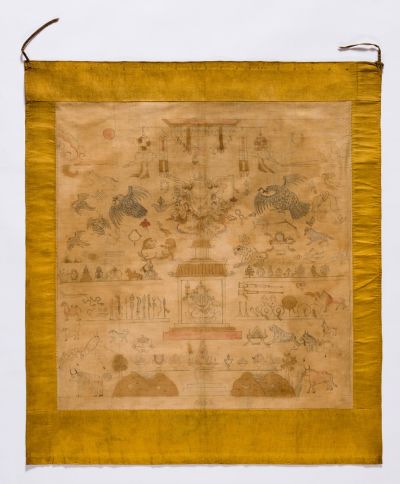
Vaiśravaṇa's offering painting
| Accession Nr.: | 99.52.1 |
|---|---|
| Type: | textile; woodblock print; thangka |
| Date of production: |
19th century
|
| Place of production: |
| Materials: | canvas |
|---|---|
| Dimensions: | height: 84 cm width: 73 cm |
The Museum’s collection contains a coloured woodblock print on cotton canvas and with a frame of cotton canvas which illustrates Vaiśravaṇa’s sacrificial paraphernalia (Tibetan: bskang rdzas; Khalkha: ganzai). In the centre, there is a palace housing Vaiśravaṇa’s typical clothing, armour, jewels, the fivepointed crown, the long earrings, the attributes he holds in his hands, the banner decorated with silk ribbons and gems, and the mongoose spitting jewels. The sacrificial paraphernalia (Tibetan: mdzos rdzas) are arranged in a circle. Below the items of clothing, the ‘seven sacrifices offered to wrathful deities are represented. The red torma cake, represented in the centre of the composition, is surrounded by flames. To the right of the garments, the Eight Auspicious Symbols (Tibetan: bkra shis rtags brgyad) are shown; to the left, the Seven Jewels (Tibetan: rin chen bdun). Below them, the weapons (Tibetan: mtshon) used by wrathful deities are depicted, including Śrīdevī's five magical weapons and her horse, along with musical instruments many of which are made of human bones or skulls. Next to them, there are objects pleasing to the deity’s eye (Tibetan: spyan rdzas): the five things to be desired, flowing banners, hanging decorations and ribbons made of bowels, various animals, other weapons (including a rifle), birds, attributes of wrathful deities, and a Mongolian costume. The composition is framed by natural elements: the sun, the moon, and clouds above, and rocks and trees enclosing a sea below.